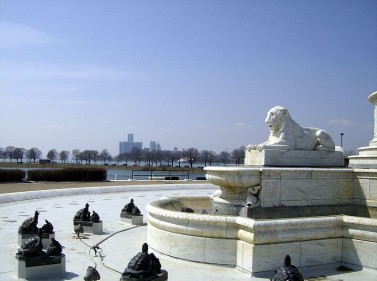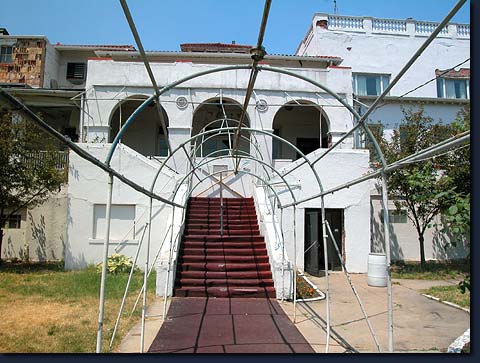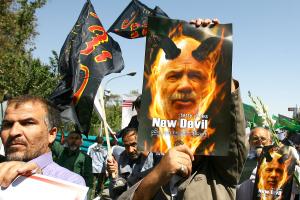
(The James Scott Fountain on Belle Isle. Detroit’s RecCen in the background.)
Detroit may be capital of the Rust Belt (sorry, Pittsburgh) but once it had a buckle of iron.
It is said that the legendary maker of the modern world, Henry Ford, met a Yemeni sailor in the early 1900s. The story has been around for generations in the Motor City. Henry was paying $5 a day for work on The Line, and his encounter with the sailor began a serial chain of migration of Yemenis to Detroit that continues to this day.
It is sort of weird. Ford was a noted and virulent anti-Semite, one of the nastier parts of the new world he was inventing, but his incidental association with emigrational patterns of humanity based on the opportunity for a decent wage transformed the Iron Belt of America.
As Detroit’s German and Polish faces were joined by people of color, the narrative of racism and conflict in the city gained strident volume. It was about work, first and foremost, and Ford was not racist, per se, in that narrow aspect of his complex legacy.
I remember asking Raven one time long ago as we drove along the Jeffries Freeway about why the big Continentals and Buicks seemed to have so many African-American drivers. Dad replied laconically that “Ford doesn’t care what color you are, so long as you have enough green.”
That was a play on Henry’s old adage that the buying public could have any color Model T that they wished, so long as it was black. I didn’t know it then, but later incorporated the phlegmatic principle of capitalism into the way we looked at the world from Detroit’s northern suburbs.
The resentment against people of color in Detroit long pre-dated the Great Migration. The first race riot in the city occurred in 1863 when the 24th Michigan Infantry of the famed Iron Brigade was off fighting the Confederates. The disorder was unsettling enough that a permanent Detroit Police Department was founded to maintain public order.
It was the behavior of that particular organization that was blamed for instigating the next great act of public disorder in another war year, 1943.
The War and Money lit the fuze to the grenade that went off on June 22nd. Detroit’s population had swollen like a boil since the war began, growing by 350,000.
The stolid Hunkies and Germans and Polacks must have blinked at the influx of Appalachians to their neighborhoods; most of the new-comers were whites from the hill-country of the near south. That was when Ypsilanti, Ann Arbor’s raffish neighbor became “Ypsi-tucky.” 50,000 of the immigrants were African American, and part of the problem was that there was no place for them to go except the Paradise Valley and Black Bottom neighborhoods, which were bursting at the seams.
The fight broke out at Belle Isle, a little open space connected to Detroit by the McArthur bridge. The flash point was a fight of some sort, either black on white or white on black. It doesn’t matter, except to note that there was enough pent up anger that the riot lasted until FDR dispatched Federal troops and restored order three days later.
The fight started at Belle Isle, the largest island park in the country, and home to the posh Detroit Yacht Club (mostly sailing craft) and Boat Club (mostly stink boats), a Coast Guard station and the James Scott fountain. It is not so posh now, and in the years after the park was both home to the enclaves of the elite and an open space for the poor.
I recall to this day the old racist tune that lingered years after:
“I woke up in the morning,
Gave my wife a smile,
Bought a watermelon,
And I headed for Belle Isle.”
There is more, but it is stupid, offensive and petty, just like life was in the bustling factory city.

(Detroit Boat Club, on Belle Isle, MI, 2005. Photo Alex Duncan.)
Belle Isle is still a nice open space, but the plush Boat Club was abandoned by the social organization in 1996 and the magnificent facility they left behind is now crumbling, though there are some renegade rowers who still use the docks. It was the oldest rowing club in the country, and the renegade rowers claim they continue the tradition that makes them the second oldest in the world.
Anyway, there I go on the black-and-white conflict that was the great narrative of the decline and fall of the Motor City. There was much more going on in the background that was obscured by the brutal suppression of African Americans. It was the rise of something else altogether that came with the call to prayer.
Henry Ford’s chance encounter with the Yemeni Sailor echoed across the oceans and made the Greater Detroit area home to one of the largest, oldest and most diverse Arab American communities in the United States.
The earliest wave of Arab immigration dates from 1890, and was composed of Syrian Lebanese Maronite Christians who settled on the east side, near the Doge Brother’s factory complex that straddled Jefferson Avenue. Legendary architect Albert Kahn designed the public end of the complex. The Kercheval body shop was on the north side of the street, with the Jefferson engine and car assembly plant on the south side. The bodies came across Jefferson in an enclosed overhead conveyer belt.
The town really hummed in those days.
Listening to Henry Ford, an enclave of Yemini Muslims established a beachhead in Highland Park, near the Ford Motor company Model T plant, and Palestinian co-believers arrived shortly before the turbulence of World War I swept over the Ottomon Empire. The Iraqi presence in the Motor City was established long before the current unpleasantness in the Gulf; in the Motor City we call them Chaldeans, since they arrived before the establishment of modern Iraq.
The major wave of Yeminis came after the great Spanish Flu epidemic ravaged the country in 1918-19. The plague, at it’s height, was killing a thousand a week in Michigan alone. Since it took mostly healthy adults, it created gaps in the workforce that the immigrants were happy to fill.
They brought their faith with them, and established the Dearborn Mosque in 1937. It was the second mosque constructed in the United States, and gained fame as a local court validated the right of the congregation to broadcast the call to pray over loudspeakers on the roof over the fervent objections of some neighbors.
The court found the noise was equivalent to the ringing of church bells, and hence constitutionally protected speech.
Which is a long way around the rose bush to the reason why that idiot pastor Terry Ford claims he is going to show up in front of the larger and more magnificent Islamic Center of North America tomorrow, Good Friday.
Terry is famous for first threatening to burn, and then actually igniting a copy of the Quran.
Most of us are fairly well used to the idea that people around the world burn our flag, or imprison people for the crime of owning or distributing copies of the Bible and shrug it off. We have that concept of “protected speech,” even if the rest of the world doesn’t.
But Terry is on to something he can use his constitutional right to do that is really irritating.In late March, Jones put the Quran “on trial” at his 50-member Dove World Outreach Center. With his congregants as jury, the holiest book in Islam was found guilty and sentenced to burn at the stake.
I am not making this up, I swear. When the self-righteous moron released videos of the burning online on YouTube, the images instigated violence against NATO forces in Afghanistan and got some people killed.
Pastor Jones claims that the Islamic Center is behind a drive to impose Sharia law in Detroit, and eventually across America. I don’t know about that, but I do know that the circus on Altar Road in Dearborn tomorrow is going to be entertaining. In addition to the Islamic Center’s call to prayer, there are several Christian churches on the street that will also be having Good Friday services.
The Lebanese paramilitary group Hezbollah has put a bounty on the pastor’s head. They seem like a distant threat, until you realize that Dearborn’s Chief of Police is a guy named Ron Haddad, a Lebanese-American, and that is just part of the face of today’s Detroit.
Get used to it, Terry.
Oh, I forgot to mention it, but although this is very much about the Pastor’s anti-Islamic agenda, it was originally organized by a Port Huron militia group known as the “Order of the Dragon.”
We have not talked about the Michigan Militia movement, and I am not sure I am going to.
But, that is Michigan for you.

(Iranians protest Pastor Terry Jones and his “Burn a Quran Day” in Tehran, Iran on September 17, 2010. UPI/Maryam Rahmanian.)
Copyright 2011 Vic Socotra
www.vicsocotra.com
